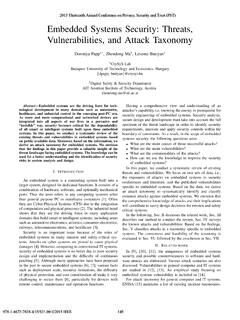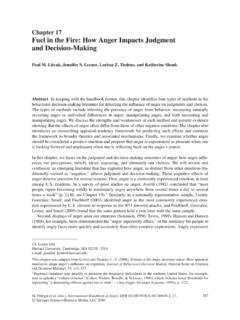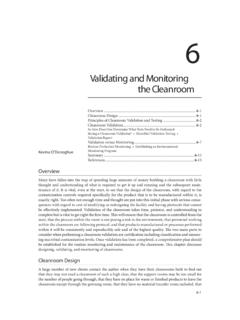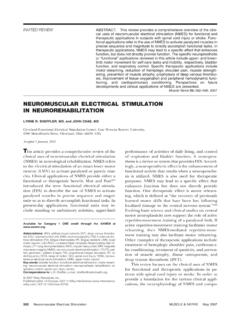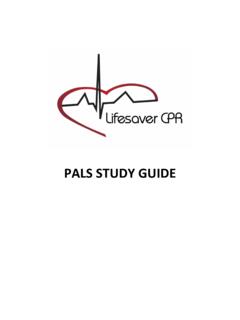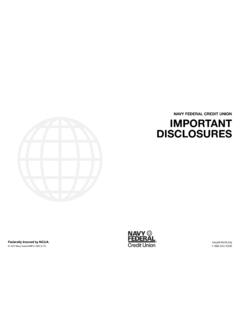Transcription of 2. Noise sources and their measurement
1 2. Noise sources and their measurement Aspects of Acoustical Measurements Most environmental noises can be approximately described by one of several simple measures. They are all derived from overall sound pressure levels, the variation of these levels with time and the frequency of the sounds. Ford (1987) gives a more extensive review of various environmental Noise measures. Technical definitions are found in the glossary in Appendix 3. Sound pressure level The sound pressure level is a measure of the air vibrations that make up sound. All measured sound pressures are referenced to a standard pressure that corresponds roughly to the threshold of hearing at 1 000 Hz.
2 Thus, the sound pressure level indicates how much greater the measured sound is than this threshold of hearing. Because the human ear can detect a wide range of sound pressure levels (10 102 Pascal (Pa)), they are measured on a logarithmic scale with units of decibels (dB). A more technical definition of sound pressure level is found in the glossary. The sound pressure levels of most noises vary with time. Consequently, in calculating some measures of Noise , the instantaneous pressure fluctuations must be integrated over some time interval. To approximate the integration time of our hearing system, sound pressure meters have a standard Fast response time, which corresponds to a time constant of s.
3 Thus, all measurements of sound pressure levels and their variation over time should be made using the Fast response time, to provide sound pressure measurements more representative of human hearing. Sound pressure meters may also include a Slow response time with a time constant of 1. s, but its sole purpose is that one can more easily estimate the average value of rapidly fluctuating levels. Many modern meters can integrate sound pressures over specified periods and provide average values. It is not recommended that the Slow response time be used when integrating sound pressure meters are available.
4 Because sound pressure levels are measured on a logarithmic scale they cannot be added or averaged arithmetically. For example, adding two sounds of equal pressure levels results in a total pressure level that is only 3 dB greater than each individual sound pressure level. Consequently, when two sounds are combined the resulting sound pressure level will be significantly greater than the individual sound levels only if the two sounds have similar pressure levels. Details for combining sound pressure levels are given in Appendix 2. frequency and frequency weighting The unit of frequency is the Hertz (Hz), and it refers to the number of vibrations per second of the air in which the sound is propagating.
5 For tonal sounds, frequency is associated with the perception of pitch. For example, orchestras often tune to the frequency of 440 Hz. Most environmental sounds, however, are made up of a complex mix of many different frequencies. They may or may not have discrete frequency components superimposed on Noise with a broad 21. frequency spectrum ( sound with a broad range of frequencies). The audible frequency range is normally considered to range from 20 20 000 Hz. Below 20 Hz we hear individual sound pulses rather than recognizable tones. Hearing sensitivity to higher frequencies decreases with age and exposure to Noise .
6 Thus, 20 000 Hz represents an upper limit of audibility for younger listeners with unimpaired hearing. Our hearing systems are not equally sensitive to all sound frequencies (ISO 1987a). Thus, not all frequencies are perceived as being equally loud at the same sound pressure level, and when calculating overall environmental Noise ratings it is necessary to consider sounds at some frequencies as more important than those at other frequencies. Detailed frequency analyses are commonly performed with standard sets of octave or 1/3 octave bandwidth filters. Alternatively, Fast Fourier Transform techniques or other types of filters can be used to determine the relative strengths of the various frequency components making up a particular environmental Noise .
7 frequency weighting networks provide a simpler approach for weighting the importance of different frequency components in one single number rating. The A-weighting is most commonly used and is intended to approximate the frequency response of our hearing system. It weights lower frequencies as less important than mid- and higher- frequency sounds. C- weighting is also quite common and is a nearly flat frequency response with the extreme high and low frequencies attenuated. When no frequency analysis is possible, the difference between A-weighted and C-weighted levels gives an indication of the amount of low frequency content in the measured Noise .
8 When the sound has an obvious tonal content, a correction to account for the additional annoyance may be used (ISO 1987b). Equivalent continuous sound pressure level According to the equal energy principle, the effect of a combination of Noise events is related to the combined sound energy of those events. Thus, measures such as the equivalent continuous sound pressure level (LAeq,T) sum up the total energy over some time period (T) and give a level equivalent to the average sound energy over that period. Such average levels are usually based on integration of A-weighted levels. Thus LAeq,T is the average energy equivalent level of the A-weighted sound over a period T.
9 Individual Noise events It is often desired to measure the maximum level (LAmax) of individual Noise events. For cases such as the Noise from a single passing vehicle, LAmax values should be measured using the Fast response time because it will give a good correlation with the integration of loudness by our hearing system. However, for very short-duration impulsive sounds it is often desirable to measure the instantaneous peak amplitude to assess potential hearing-damage risk. If actual instantaneous pressure cannot be determined, then a time-integrated peak' level with a time constant of no more than ms should be used (ISO 1987b).
10 Such peak readings are often made using the C- (or linear) frequency weightings. Alternatively, discrete sound events can be evaluated in terms of their A-weighted sound exposure level (SEL, for defintion see appendix 5). The total amount of sound energy in a 22. particular event is assessed by the SEL. One can add up the SEL values of individual events to calculate a LAeq,T over some time period, T, of interest. In some cases the SEL may provide more consistent evaluations of individual Noise events because they are derived from the complete history of the event and not just one maximum value. However, A-weighted SEL.










